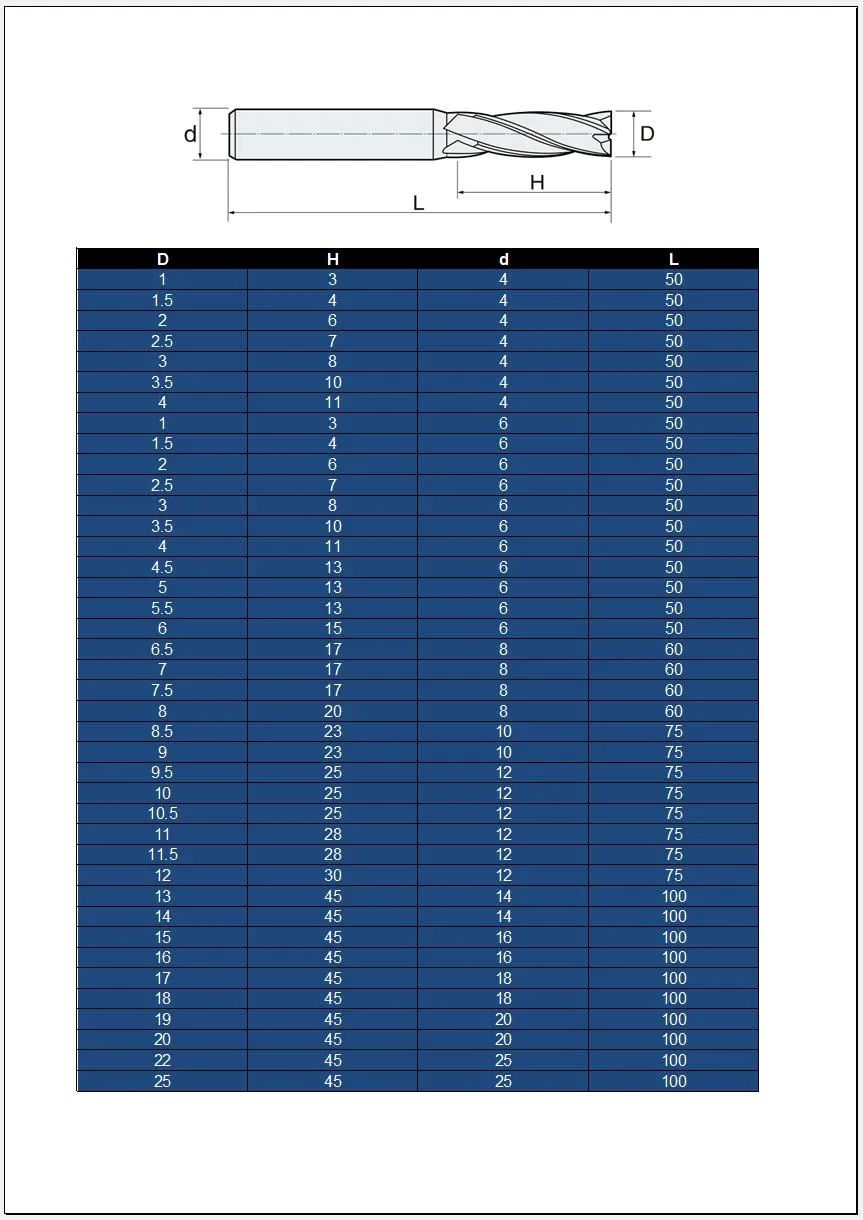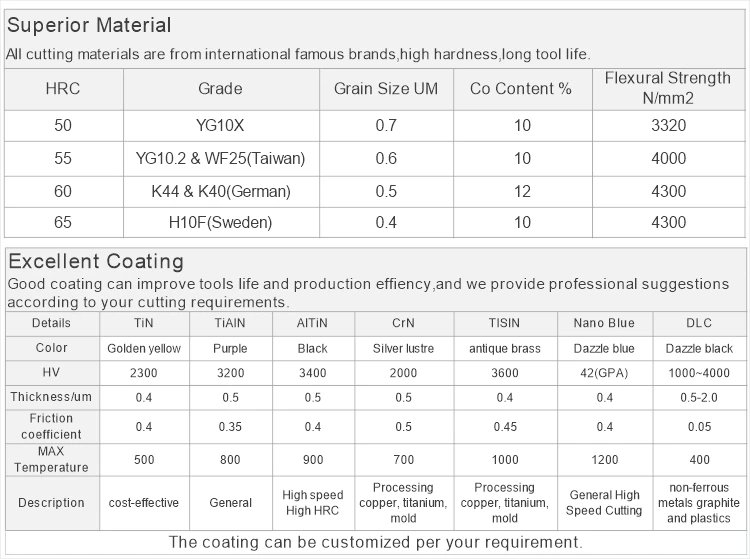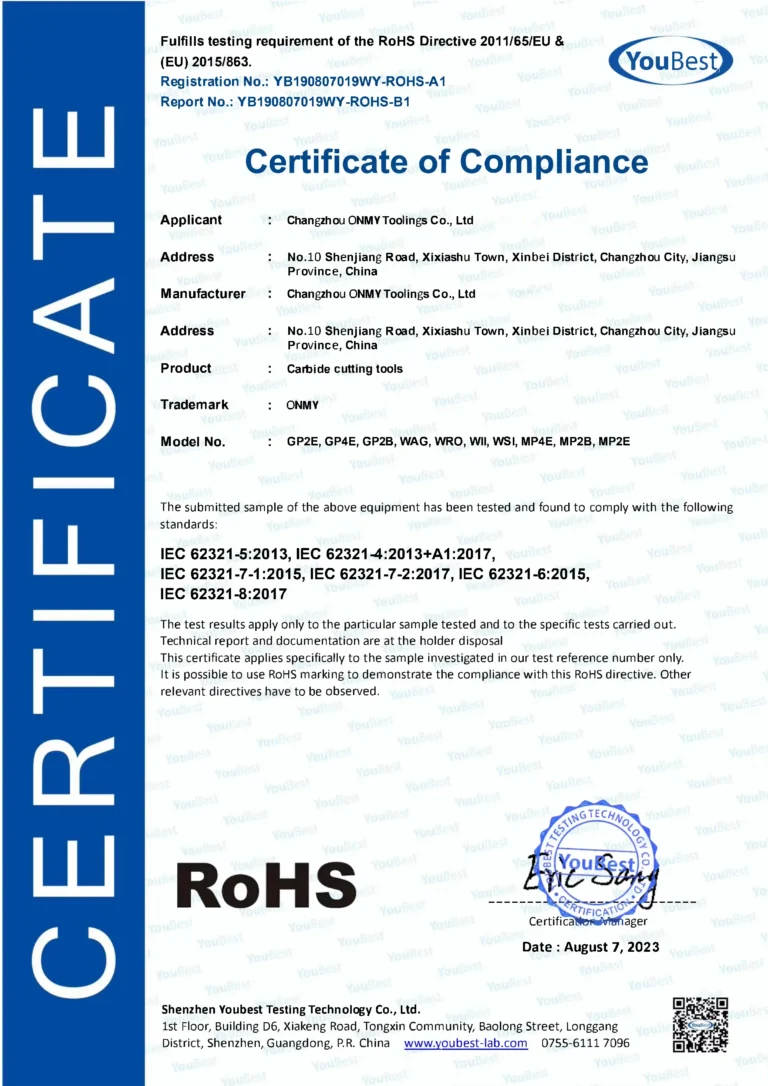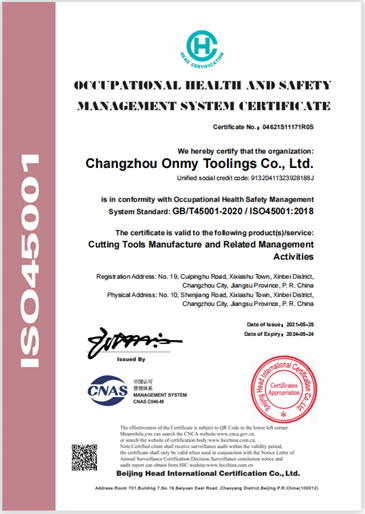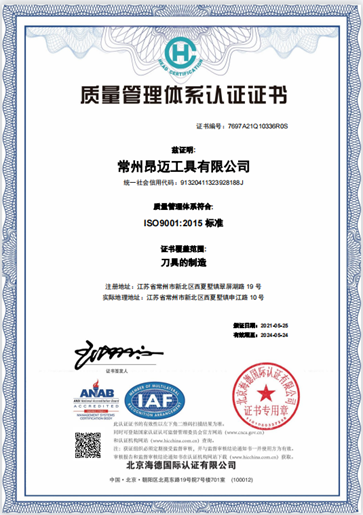4刃立銑刀
A 4 flute end mill is a rotary cutting tool commonly used in milling operations for machining materials like metal, plastics, and wood. It features four helical cutting edges (flutes) that run along its cylindrical body, allowing for efficient material removal and smooth surface finishes. The four-flute design provides a balance between chip evacuation and cutting stability, making it suitable for a wide range of applications. These end mills can perform both side cutting and plunging operations, and are often used for tasks such as slotting, profiling, and contouring in various industries including manufacturing, aerospace, and automotive.
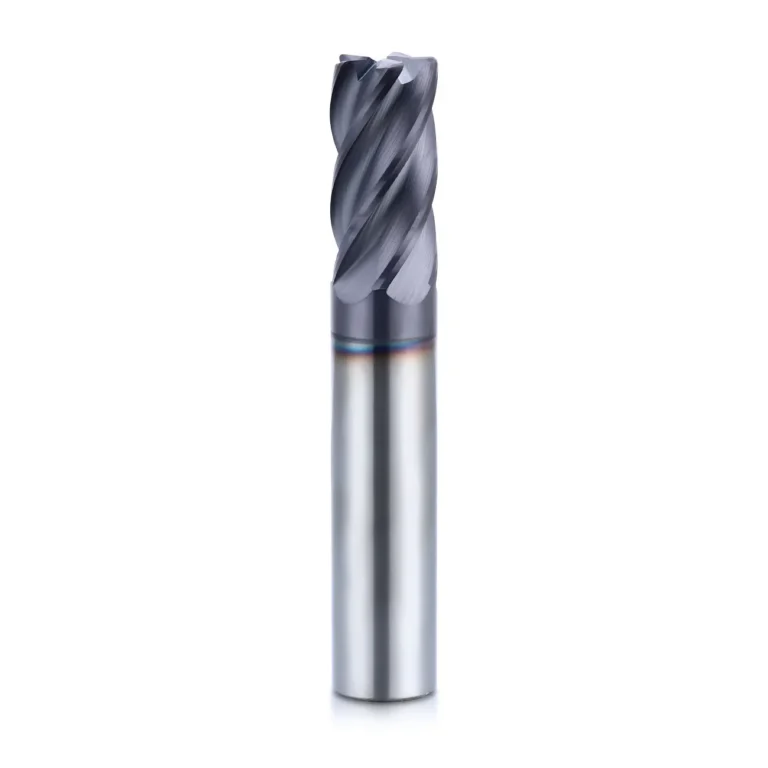
4 flute end mill Application
4 flute end mills have a wide range of applications in machining. Here’s a concise overview of their main uses:
- General milling operations
- Slotting and slot milling
- Profiling and contouring
- Side milling
- Plunge cutting
- Finishing passes
- Machining harder materials
- High-speed machining
- Precision work in aerospace and automotive industries
- Mold and die-making
These end mills are particularly effective when working with metals like steel, stainless steel, and aluminum. They’re often chosen for their ability to produce smooth finishes and maintain dimensional accuracy.
4 flute end mill Features
4 flute end mills are a versatile cutting tool commonly used in various machining applications. Here are four of their key features:
1. Increased Core Thickness and Strength
- Compared to end mills with fewer flutes, 4 flute end mills have a thicker core.
- This thicker core provides enhanced rigidity, reducing tool deflection during cutting.
- This translates to better accuracy and improved surface finish.
2. Reduced Chip Load
- The four flutes distribute the cutting load more evenly.
- This reduced chip load per flute results in smoother cutting action.
- It helps prevent chip build-up and improves overall cutting efficiency.
3. 多功能應用
- 4 flute end mills are suitable for a wide range of materials, including cast iron, tool steel, stainless steel, and heat-treated steels.
- They can be used for various machining operations such as slotting, profiling, and pocketing.
4. 改進的表面飾面
- Due to the reduced chip load and increased rigidity, 4 flute end mills produce better surface finishes compared to end mills with fewer flutes.
- This is especially beneficial for applications where a smooth surface is required.
Most of Chinese suppliers have same quality, but we are not the same,why?


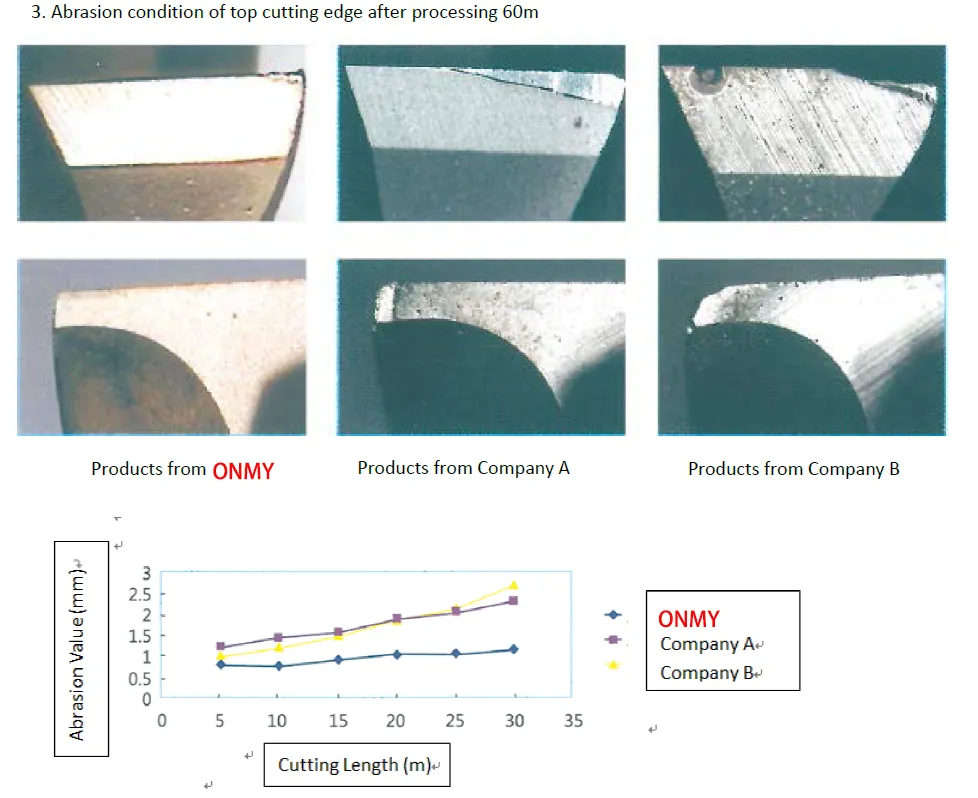
ONMY TOOLINGS 的差異
是什麼讓我們的單槽立銑刀與眾不同?這是我們獨特的組合:
先進的硬質合金配方
我們使用針對強度和耐磨性進行最佳化的專有微晶碳化物混合物。
創新的幾何形狀
我們專利的槽設計可最大限度地排屑並最大限度地減少切削力。
尖端塗料
我們採用奈米層狀 PVD 塗層來增強耐熱性並減少摩擦。
精密研磨
我們的多軸 CNC 磨床的公差可達 ±0.0005 英吋。
Don't just take our word for it. Here's what our satisfied customers have to say:
我快樂的客戶!

立即取得您的客製報價!
附:我們是否提到我們提供批量折扣?訂購越多,節省越多!
- 無與倫比的工廠直銷定價:省去中間商,與零售價相比可節省高達 40%。我們高效的製造流程使我們能夠以具有競爭力的價格提供優質的產品。
- 閃電般的快速交付:憑藉我們簡化的生產流程,我們提供業界領先的周轉時間。只需 7 天即可獲得客製化立銑刀!我們擁有大量標準尺寸庫存,可立即出貨。
- 個人化服務:我們的專家工程師團隊隨時準備協助您找到應對獨特加工挑戰的完美解決方案。我們提供免費諮詢來分析您的特定需求並推薦理想的工具規格。
經常問的問題
- For roughing operations in softer materials: A 3 flute end mill might be a good choice.
- For finishing operations or harder materials: A 4 flute end mill is often preferred
4 flute end mills are primarily used for:
- General milling operations in metals and plastics
- Slotting and groove cutting
- Profiling and contouring complex shapes
- Side milling for creating straight edges
- Finishing passes to achieve smooth surfaces
- Plunge cutting for creating holes or pockets
- High-speed machining operations
- Precision work in aerospace and automotive parts
- 黴菌和模具
- Machining harder materials like stainless steel
They’re favored for their balance of cutting efficiency and surface finish quality, especially in materials like steel and aluminum. The four-flute design allows for faster feed rates compared to two-flute mills, while still maintaining good chip evacuation.
2 Flute End Mills:
- Better chip evacuation
- Ideal for softer materials (e.g. aluminum, brass, plastics)
- Preferred for deep pockets and slots
- Higher feed rates possible
- Better for plunge cutting
- More suitable for roughing operations
4 Flute End Mills:
- More cutting edges for smoother finishes
- Better for harder materials (e.g. steel, stainless steel)
- Increased stability and reduced vibration
- Superior for side milling operations
- Better for maintaining tight tolerances
- More suitable for finishing operations
Key differences:
- Chip clearance: 2 flute better
- Surface finish: 4 flute generally superior
- Material suitability: 2 flute for softer, 4 flute for harder
- Cutting speed: 4 flute typically faster
- Application: 2 flute for roughing, 4 flute for finishing
Yes, 4 flute end mills can be used for aluminum, but they’re not always the optimal choice. Here’s a brief explanation:
- Possible, but not ideal: 4 flute end mills can machine aluminum, especially in finishing operations.
- Chip evacuation: The main concern is that aluminum tends to produce long, stringy chips. 4 flute mills have less space between flutes for chip evacuation.
- Heat buildup: More flutes can lead to more heat generation, which is problematic with aluminum as it can cause the material to become gummy.
- Better alternatives: 2 or 3 flute end mills are generally preferred for aluminum. They offer better chip clearance and heat dissipation.
- Specific cases: High-speed machining of aluminum or finishing passes where surface finish is critical might benefit from a 4 flute tool.
- Coatings: If using a 4 flute mill on aluminum, look for ones with appropriate coatings to reduce friction and heat.
In summary, while it’s possible to use a 4 flute end mill on aluminum, it’s often not the first choice due to chip evacuation concerns. The best tool depends on the specific operation and requirements.
- Bulk material removal: Quickly removing large amounts of material from workpieces.
- Hogging: Aggressive cutting to create rough shapes or cavities.
- Roughing passes: Preparing a workpiece for subsequent finishing operations.
- High metal removal rates (MRR): Maximizing the volume of material removed per unit time.
- Machining harder materials: Effective on tough materials like steel and stainless steel.
- Creating pockets: Rapidly hollowing out areas in a workpiece.
- Stock removal: Quickly reducing the size of raw stock.
- Adaptive milling: Used in modern CNC strategies for efficient material removal.
- Slotting: Creating rough slots or grooves.
- Preparation for finishing: Setting up the workpiece for final dimensioning and surface finishing.
Generally, 2 flute end mills are preferred for machining aluminum.
- Chip evacuation: Aluminum produces long, stringy chips. The larger flute spaces in a 2 flute end mill allow for better chip clearance, preventing chip build-up and clogging.
- Material removal rate (MRR): While 4 flute end mills can theoretically achieve higher MRR, the chip evacuation issue often offsets this advantage in aluminum machining.
- 刀具壽命: In many cases, 2 flute end mills can provide longer tool life in aluminum due to the reduced stress on the cutting edges.
Exceptions
That said, there are situations where a 4 flute end mill might be considered for aluminum:
- Finishing operations: For very fine finishes, a 4 flute end mill might be preferred due to its smoother cutting action.
- Small diameter end mills: In some cases, with small diameter end mills, a 4 flute might offer better rigidity.
- High-speed machining (HSM): Under specific HSM conditions, a 4 flute end mill can be effective.
Ultimately, the best choice depends on specific factors such as:
- 鋁合金
- Cutting conditions (speed, feed, depth of cut)
- 所需的表面飾面
- Tooling availability

